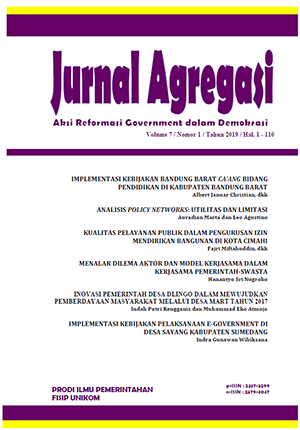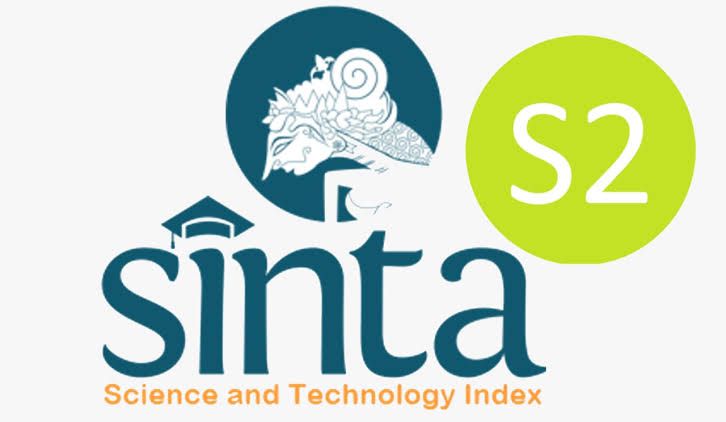POLICY NETWORKS ANALYSIS: UTILITY AND LIMITATIONS
DOI:
https://doi.org/10.34010/agregasi.v7i1.1542Keywords:
policy networks, utilitas, limitasiAbstract
The main problem in this paper is that there are doubts about the concept of policy network in policy studies. This doubt has been written by Dowding by debating policy networks as Methapor or Model. To that end, the article was written with the aim to discuss the development of the concept of policy network and explain the utility and limitation of the concept in explaining the policy process. Policy networks are in principle a study that seeks to explain the relationships between actors and their interests and resources in order to influence the policy process. Each actor will bring their interests and preferences and bargain between actors so that the linkage of actors form the typology of policy networks. More holistically, the utility of policy networks is directed to be able to answer the main question in network studies ie how does the network appear? How can the network remain and change? How can changes in the network occur? While the limitation of the use of the concept of policy networks is more on the empirical level that uses it in research with in-depth study because to see the complexity of actors, relationships between actors, and interests is not easy and as simple as thought.
Downloads
References
Adelle, C., Jordan, A., & Benson, D. (2015). The role of policy networks in the coordination of the European Union’s economic and environmental interests: The case of EU mercury policy. Journal of European Integration, 37(4), 471-489.
Araral, E., Fritzen, S., Howlett, M., Ramesh, M., & Wu, X. (Eds.). (2013). Routledge handbook of public policy. Routledge.
Bank, World. (1989). Sub-Saharan Africa: From Crisis to Sustainable Growth: A Long- Term Perspective Study. Washington, D.C.: World Bank
Bevir, M. (Ed.). (2011). The SAGE handbook of governance. London, Thousand Oaks, New Delhi: SAGE Publications
Birkland, T. A. (2007). Agenda setting in public policy. Handbook of public policy analysis: Theory, politics, and methods, 125, 63-78.
Cumpston, H. (2009). Policy Networks and Policy Change Putting Policy Network Theory to the Test. New York: Palgrave Macmillan
Daugbjerg, C., & Pedersen, A. B. (2004). New policy ideas and old policy networks: implementing green taxation in Scandinavia. Journal of public policy, 24(2), 219-249.
Daguerre, A. (2000). Policy Network in England and France: The Case of Child Care Policy 1980-1989. Journal of European Public Policy, 7, 244-260
Hansen, J. B. (1997). A “New Institutional†Perspective on Policy Networks. Public Administration, 75, pp 669–693)
Hudson, J. et al. (2007). Activating Policy Networks A case study of local environmental policy-making in the United Kingdom. Policy Studies, 28,(1), 55-70
Jordan, G. (1990). Sub-governments, policy communities and networks: refilling the old bottles?. Journal of theoretical politics, 2(3), 319-338.
Jordan, G., & Schubert, K. (1992). A preliminary ordering of policy network labels. European journal of political research, 21(1â€2), 7-27.
Kenis, P., & Raab, J. (2003). Wanted: A good network theory of policy making. In 7th National Public Management Conference.
Kenis, P., & Schneider, V. (1991). Policy networks and policy analysis: scrutinizing a new analytical toolbox. In Policy networks: Empirical evidence and theoretical considerations (pp. 25-59). Campus Verlag.
Klijn, E. H. (1996). Analyzing and managing policy processes in complex networks: A theoretical examination of the concept policy network and its problems. Administration & Society, 28(1), 90-119.
Klijn, E. H., & Koppenjan, J. F. (2000). Public management and policy networks: foundations of a network approach to governance. Public Management an International Journal of Research and Theory, 2(2), 135-158.
König, T. (1998). Introduction: Modeling policy networks. Journal of Theoretical Politics, 10 (4), 387–388
Marin, B., & Mayntz, R. (1991). Policy networks: Empirical evidence and theoretical considerations. Campus Verlag.
Marsh, D., & Smith, M. (2000). Understanding policy networks: towards a dialectical approach. Political studies, 48(1), 4-21.
Melbeck, C. (1998).Comparing Local Policy Networks. Journal of Theoretical Politics, 10, 531-552.
Ng, K. H. (2007). Political context, policy networks and policy change: the complexity of transition in Hong Kong. The Pacific Review, 2, (1), 101–126.
Van Der Pennen, T. (2005). Actor strategies in decentralized policy networks. Journal of Housing and the Built Environment, 20(3), 301-315.
Peters, B. G., & Pierre, J. (Eds.). (2006). Handbook of Public Policy. London,· Thousand Oaks,· New Delhi: SAGE Publications.
Rhodes, R. A. (1990). Policy networks: a British perspective. Journal of theoretical politics, 2(3), 293-317.
Rhodes, R. A., & Marsh, D. (1992). New directions in the study of policy networks. European journal of political research, 21(1â€2), 181-205.
Sabatier, P. A & Jenkins-Smith, H. (1988). An Advocacy Coalition Framework of Policy Change and the role of policy-oriented learning therein. Policy Sciences, 21, (129-168).
Schneider, M. et al. (2003). Building Consensual Institutions: Networks and The National Estruary Program. American Journal of Political Science, 47(1), 143-158.
Schneider, V. (1992). The Structure of Policy Networks: A Comparison of The Chemicals Control and Telecommunications Policy Domains in Germany. European Journal of Political Research, 21(1-2), 109-129.
Thatcher, M. (1998). The development of policy network analyses: From modest origins to overarching frameworks. Journal of theoretical politics, 10(4), 389-416.
Thatcher, M., & Braunstein, J. (2015). Issue Networks: Iron Triangles, Subgovernments, Policy Communities, Policy Networks. International Encyclopedia of the Social & Behavioral Sciences, 2nd edition, 12, 769-773.
Van Waarden, F. (1992). Dimensions and types of policy networks. European journal of political research, 21(1â€2), 29-52.
Weible, C. M., & Sabatier, P. A. (2005). Comparing policy networks: Marine protected areas in California. Policy Studies Journal, 33(2), 181-201.
Downloads
Published
Issue
Section
License
This work is licensed under :

Creative Commons Attribution-NonCommercial 4.0 International License









